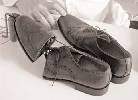Two exhibitions
dal 14/9/2004 al 23/10/2004
Segnalato da
14/9/2004
Two exhibitions
Lisson Gallery, London
Lisson Gallery has pleasure in announcing the eleventh show at the gallery by Sol LeWitt since he first exhibited in the early days of Lisson in 1969. At Lisson new space: Mark Hosking's sculptural work is often described through narrative. Objects, remade and transformed by the artist, are seen as the residues of scenarios of self-preservation and redemption from adverse and unexpected situations or disasters.

Sol Lewitt
The historical achievement of Sol LeWitt over his long and distinguished career has become legendary. After his first solo show in Britain at the Lisson Gallery, London in 1971, The Times Review described the work as a "novel kind of drawing done directly onto the wall". This was followed by his first museum show in Britain at the Museum of Modern Art, Oxford in 1973, curated by Nicholas Serota.
LeWitt is perhaps best known for his geometric wall paintings of circles, squares, triangles, rectangles and the complex forms derived from them. This exhibition, specially conceived by the artist for the Lisson Gallery space, will include two of the latest wall paintings within the main ground floor gallery that will face each other across the L-shaped exhibition space. The first of these will occupy the three large walls of the gallery with a colour palette of red, yellow, blue, orange, purple and green with the second in a strict tonal palette of black, grey and white.
LeWitt was pivotal in the creation of the new radical aesthetic of the 1960's that was a revolutionary contradiction to the 'Abstract Expressionism' current in the 1950's and 1960's New York school. He had no interest in inherent narrative or descriptive imagery. LeWitt, like no other artist of his generation, has always maintained the importance of the concept or idea and, apart from his original works on paper, the work is executed by others to clear and strict instructions.
As one of the first coherent spokespersons on conceptual art with his writings, Sentences on Conceptual Art, 1969, LeWitt's work continues to be regarded and referred to by a younger generation of artists as one of the seminal investigations into 'idea' and 'concept' art. He has continued to challenge new thinking about what art can be. "If the artist carries through his idea and makes it into visible form, then all the steps in the process are of importance. The idea itself, even if not made visual, is as much a work of art as any finished product" stated LeWitt in 1971. "All intervening steps, scribbles, sketches, drawings, failed work models, studies, thoughts, conversations, are of interest. Those that show the thought process of the artist are sometimes more interesting than the final product."
Sol LeWitt was born in Hartford, Connetticut in 1928, where he continues to live and work today. After studying a bachelors degree in Fine Art at Syracuse University until 1949, he worked as a graphic designer for I.M. Pei's architecture office in New York. He has exhibited internationally and his works hang in the Tate Modern, London, Guggenheim Museum, the Museum of Modern Art, Dia:Beacon, the National Gallery of Art, Washington D.C. and the Hirschhorn Museum and Sculpture Garden.
Lisson Gallery London
52-54 Bell Street
London
_________________________
Mark Hosking
At Lisson new space
Mark Hosking’s sculptural work is often described through narrative. Objects, remade and transformed by the artist, are seen as the residues of scenarios of self-preservation and redemption from adverse and unexpected situations or disasters. Another dimension to Hosking’s practice rebels against the fixed status assigned to objects within western consumer society through challenging their former use-value. At Lisson New Space Hosking continues this critique of commodity. A broken chair found on the streets of Paris is redeemed from its obsolescence and is transformed through meticulous labour: in a repetitive and absurd action, the artist uses telephone cabling wire to restore the original weave of the seat. The telephone remains connected both to the chair and a wall-socket so that its former use is not defeated but transformed: incoming calls can continue to be received through the chair as a homogenised unit. Along with the chair two works are exhibited in binary opposition. A rope made out of city-workers’ ties signals freedom and an improvised means of escape, while in Net/ Gain/ Loss, 2004, a net made out of extension cable is suspended from the ceiling and supports a TV monitor with footage of a person caught. This opposition of capture and freedom could be understood as a metaphor for the liberating process of object transformation that frees materials from their predetermined systems in Hosking’s pieces. Hosking evokes a disquieting conversation in Shoe Morse 2004 when a man and woman make a pair of Morse code handsets out of their formal shoes. The couple converse with one another via the de-coded messages drummed out on their shoe heels and some DIY electronics. Mark Hosking’s solo exhibitions include Radio Mayday at IBID Projects, London (2003), L’Elac, Geneva and Jerwood Gallery, London (2001). He has been included in group shows at Arnolfini, Bristol, Institute of Contemporary Arts, London and Kunstverein Bregenz (all 2001) as well as the Lisson Gallery shows Ideal Standard Summertime (1995) and A Shot in the Head (2000).
Image: Work by Mark Hosking
Lisson new space
29 Bell Street
London



